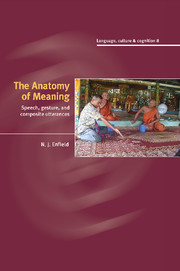4 - Hand-pointing
Published online by Cambridge University Press: 21 July 2009
Summary
If one has the attitude of the person throwing the ball, he can also have the response of catching the ball.
G.H. Mead, 1934Despite long being considered the simplest, most primitive form of communicative action (Wundt 1973 [1921]: 74–75), the humble pointing gesture has much to reveal about the nature of human social intelligence and mind. For nearly a century, scholarly considerations of pointing gestures have addressed questions of the very foundations of signification, from psychologists' ruminations on their production and comprehension (Wundt 1973 [1921]: 74–75, Bühler 1982 [1934]: 45), to philosophers' concerns with notorious puzzles of ostensive reference (Wittgenstein 1953: §33, Quine 1960: 100–101; cf. Peirce 1965 [1932]: §2.305), to pioneering ethnographic descriptions of pointing's role in different cultural settings (Efron 1972 [1941]: 96–97, Sherzer 1973, Haviland 1993). In more recent decades, most work on pointing has focused on its cognitive and semantic status as a proto-linguistic mode of human communication. Pointing is argued to be a critical precursor to language, both in phylogeny (e.g. Hewes 1981, 1996, Rolfe 1996) and ontogeny (Scaife and Bruner 1975, Bates et al. 1975, Ohama 1984, Schaffer 1984, Bates et al. 1987, Carpenter et al. 1988, Butterworth and Morissette 1996, Butterworth 2003, inter alia). Pointing is now understood to constitute a uniquely human mode of joint-attentional behaviour (Povinelli et al. 2003, Tomasello 2006).
- Type
- Chapter
- Information
- The Anatomy of MeaningSpeech, Gesture, and Composite Utterances, pp. 90 - 110Publisher: Cambridge University PressPrint publication year: 2009

